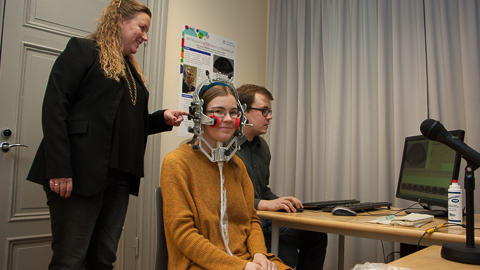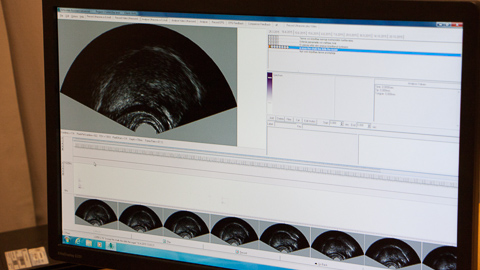Ultrasound Reveals How Speech Sounds Are Formed
The Department of Phonetics at the University of Turku is the first one in the world to combine both ultrasound technology and research on the evoked potentials of the brain in the development of language education. With the two different methods, researchers are looking for new, more effective ways to teach foreign languages. The research can also have applications in the treatment of speech disorders in the future.

When Elisa Reunanen speaks, Maija S Peltola and Antti Saloranta see the position of the speech sounds as an image on the computer screen. The researchers are carrying out a comparative study, where one group is taught a foreign language with traditional methods and the other 's instruction includes advice on how to position their lips and mouth to produce speech sounds in ways that the ultrasound has revealed. – There is a great difference between the two groups to the advantage of the new teaching methods, says Peltola.
Docent Maija S. Peltola confesses that the new research method was created rather accidentally. A researcher working in Scotland told her about the ultrasound laboratory. The leaflet lay around her papers for a year until Peltola decided to throw it away.
– I thought that I wouldn't need it for anything. But then I realised that this is exactly what I need. You can do so many things with the device. Now we are the first research group in the world who uses the ultrasound laboratory to develop education, says Peltola.
The University granted infrastructure funding for procuring the device and the laboratory was completed in the autumn with the support of the School of Languages and Translation Studies. The Department's Learning, Age and Bilingualism Laboratory (LAB-lab) has also an EEG laboratory so that the researchers can study the development and evoked potentials of the brain. By combining the results, the researchers can discover completely new methods for teaching the formation of speech sounds.
– When people are learning a foreign language, they also have to learn how to position their mouth in new ways. So far, we have been able to study the formation of speech sounds only with acoustics. However, similar speech sounds can be formed in many different ways,  says Maija S. Peltola and gives examples of the
says Maija S. Peltola and gives examples of the
Finnish speech sound ö. If Peltola was wearing the "helmet" used in the ultrasound, images would appear on the screen and reveal the different positions her lips and tongue take when producing the sounds.
Aid for Language Education
The results facilitate the teaching of foreign languages, as the device shows how a native speaker forms speech sounds. Knowing that, it is easier to teach students how to position the lips or tongue in order to produce the correct speech sound.
– At the moment, we don not know what the speech sounds look like in the mouth but we will have that information soon. Speakers of many different languages can be found in Turku and we can ask them to participate in the study. At the same time, we can study the evoked potentials of the brain. By combining the data, we will receive new information on how memory traces are created in the brain, among other things, describes Peltola.
The Department is collaborating with the Queen Margaret University in Edinburgh which developed the ultrasound. The collaboration also offers an opportunity to request alterations to the device which will better serve research.
In addition, the ultrasound has clinical applications. For example, the ultrasound could reveal why people with speech sound disorders cannot form speech sounds correctly.
The device is already used in research: A Master's thesis on the Russian vowels is under way, but the research for the thesis has also involved testing the device and finding best practices.
– This time next year, we will produce our first research results where the ultrasound technology has been utilised, says Peltola.
Pioneer in the Ultrasound Research
The Department has language laboratories donated by Sanako PLC in Londin and Barcelona. A new laboratory will be established in Davis, a city in the United States, and negotiations are ongoing with Sydney in Australia, Nijmegen in the Netherlands, Tübingen in Germany, Tartu in Estonia and San Diego in the United States. Some of them include a laboratory for researching evoked potentials but none have the ultrasound technology in their use.
Peltola's next goal is to strengthen and expand the collaboration with the laboratories. The ongoing collaboration that started two years ago has proven to be even more extensive than expected. The laboratories have compared the speech acquisition of Finnish, Swedish, English and Catalan speakers and next they will study bilingual speakers of Spanish and English.
– I would also like to research the brain activity of Chinese and English speakers. Unlike English, Chinese is a tone language, which means that different tones change the meaning of words. We know that broadly speaking music is situated in the right cerebral hemisphere and languages in the left. Is Chinese situated in the right hemisphere? Who knows? We will, soon.
In addition to strengthening the international collaboration, the researchers are hoping to add a head turn laboratory in the LAB-lab, which would enable them to compare the linguistic development of monolingual and bilingual children.
Text and photos: Erja Hyytiäinen
Translation: Mari Ratia